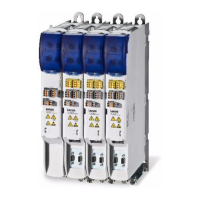5 Motor control & motor settings
5.10 Synchronous motor (SM): Pole position identification
109
Lenze · i700 servo inverter · reference manual · DMS 3.0 EN · 06/2016 · TD06
_ _ _ _ _ _ _ _ _ _ _ _ _ _ _ _ _ _ _ _ _ _ _ _ _ _ _ _ _ _ _ _ _ _ _ _ _ _ _ _ _ _ _ _ _ _ _ _ _ _ _ _ _ _ _ _ _ _ _ _ _ _ _ _
5.10.3 Pole position identification PPI (min. movement)
Functional description
If servo control for synchronous motor is set and if no error is pending, the current position is
memorised after controller enable, and the current is increased along a ramp for 10 s to 35 % of the
rated motor current. This will cause the rotor to align, which, however, is compensated by a position
control. If the rotor makes an electrical movement of more than 20°, an error message is output, and
the value measured is discarded. This might occur in the case of motors with considerable detent
torques.
If the current has reached its final value, a plausibility check is executed after a short interval: In
order to detect a non-permissible blocking of the motor, a positive and negative test angle (± 20°)
relative to the current position are defined after the identification. The motor must align itself to
these two test angles within a tolerance of 25 %.
Preconditions for the execution
• The motor must not be braked or blocked during the pole position identification.
• The servo inverter is free of errors and is in the "Switched on
" device status.
Response of the motor during the execution
The motion of the motor will maximally correspond to the set "Max. permissible motion" (Lenze
setting: 20°). If a greater motion is detected via the encoder system, the pole position identification
is cancelled and the parameterised error response (Lenze setting: Fault) is triggered.
Danger!
The motor must not be braked or blocked during the pole position identification! For this
reason, this function is not permitted for hanging loads!
Stop!
Check the correct parameterisation of the followng monitoring modes before carrying
out the pole position identification to prevent the motor from being permanently
damaged in the event of an error:
• Monitoring of the motor utilisation (I²xt)
( 254)
• Monitoring of the ultimate motor current
( 271)

